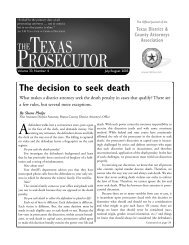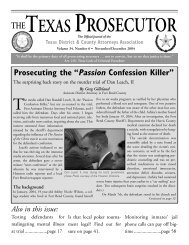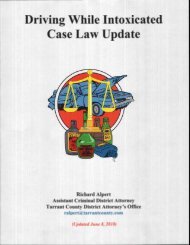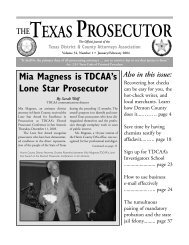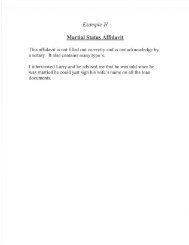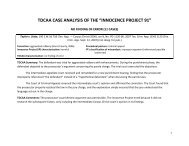Driving While Intoxicated Case Law Update - Texas District ...
Driving While Intoxicated Case Law Update - Texas District ...
Driving While Intoxicated Case Law Update - Texas District ...
You also want an ePaper? Increase the reach of your titles
YUMPU automatically turns print PDFs into web optimized ePapers that Google loves.
fesf resu/fs were not inflammatory in any sense and they Telate[d] directly to the charged offense.<br />
4) The breath fesf resu/fs did not have a tendency to confuse or distract the jury from the main<br />
t'ssues because the results related directly to the charged offense.<br />
5) The breath fesf resulfs did not have any tendency to be given undue weight by the jury. Srnce<br />
fhe Sfafe's expert testified that the breath fesf resu/fs could not be used to determine what<br />
appellant's breath alcohol concentration was at the time he was sfoppe d, the trial court could have<br />
reasonably concluded that the jury was equipped to evaluate the probative force of the breath test<br />
resu/fs.<br />
The Court of Criminal Appeals did not say that breath fesf resu/fs witt atways be admissible in the<br />
face of a Rule 403 challenge. /f suggesfed that if a jury was not given adequate information with<br />
which to evaluate the probative force of breafh fesf results, it might be reasonable to conclude that<br />
the admission of such evidence would pose a danger of misleading the jury. lt further suggesfed<br />
that if the fesf was administered to an accused several hours after he was stopped and the results<br />
were at or below the legal limit, it might be concluded that the probative force of the fesf resu/fs was<br />
too weak to warrant admission in the face of a Rule 403 challenge.<br />
State v. Mechler, 153 S.W.3d 435 (Tex.Crim.App.2005).<br />
This is a post Stewart case where the Court held that the prejudice of admitting evidence of breath<br />
testing machine results taken one and a half hours after defendant's arrest did not outweigh its<br />
probative value, and thus results were admissible. The Court so held even though it mentioned<br />
the State had other evidence of intoxication and may not have needed the results to convict in this<br />
case.<br />
3. PREJUDTCE OUTWETGHS PROBATTVE (A RTDTCULOUS OPTNION)<br />
State v. Franco, 180 S.W.3d 219 (Tex.App.-San Antonio 2005, pdr refused).<br />
Ihlsarose fromthe Sfafe's appeatof aMotion foSuppress Blood Iesf Resu/ts inanlntoxication<br />
Manslaughter/lntoxication Assault case. The facts in brief were that the crash was caused by<br />
defendant running a sfop sign that he claimed he did nof see. The offense occurred at 7:50 p.m.<br />
The test resu/fs in question were two blood fesf resu/fs: one was taken at 10:05 p.m. and was a<br />
.07; the second was taken at 11:55 and was a .02. There was a/so a PBT used at the scene that<br />
showed a .09. The Court applied a four part fesf as follows:<br />
1) What is the probative value of the evidence? The Court found the probative value of the resu/fs<br />
of Franco's blood fesfs are significantly diminished by the two and four hour delay in obtaining the<br />
samp/es and by the fact that both resu/fs are below the legal limit, and coupled with the fact that<br />
there was no ertrapolation evidence (this was held properly excluded in this same opinion). This<br />
factor was found to go in the defendant's favor (? Added by me).<br />
2) The potential to impress the jury in some irrational yet indelible way: ln its examination of this<br />
rssue, the Court sfafed it could not fathom a reason for the Sfafe fo introduce fesf resu/fs showing<br />
blood alcohol concentration below the legal limit other than to invite the jury "to conduct its own<br />
crude retrograde extrapolation," but it admitted that the lexas Court of Criminal Appeals has<br />
rejected this argument (in Stewart which, until this was handed down, was the worst opinion<br />
to come out of San Antonio Court of Appeals). lt then conceded the results showed the<br />
defendant consumed alcohol and found that part of the test favored admission.<br />
3) The time needed to develop the evidence: This factor a/so was found to favor admission.<br />
85



